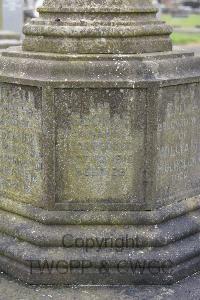Cemetery: Harrogate (Stonefall) Cemetery
Country: England
Area: Yorkshire
Rank: Private
Force: Army
Official Number: 330662
Unit: Yorkshire Hussars
Country of Service: British
Details: 10/10/1918 aged 26 interred Grangegorman Military Cemetery SON OF WILLIAM & MARY MULHOLLAND On the 10th of October 1918 at a little before nine o'clock in the morning, the City of Dublin Steam Packet Company owned mailboat - the R.M.S. Leinster - left Kingstown (now Dun Laoghaire) on route for Holyhead. Three members of the Royal Navy manned 12 pound guns on board as a precaution. Including these three men there totalled 771 on board. Of these, 489 were military and 180 were civilian passengers. 22 Dublin Post Office workers and 77 crew accounted for the rest. An hour into her journey, a torpedo was launched by U-boat UB-123, which just missed the Leinster. A second torpedo struck the Leinster in the area of the sorting room, and just one of the 22 workers inside would survive. Captain William Birch - Irish, but living in Holyhead in a property named 'The Sycamores' - gave the order to turn the ship and attempt to get back to Kingstown harbour. The third torpedo struck amid ships in the engine room, causing devastating damage, and the ship began to sink. Survivors found themselves struggling in rough seas, and by the time rescue boats arrived 501 would have perished. This was the largest maritime disaster ever witnessed on the Irish Sea, with multinational loss of life, including Welsh, Irish, Scottish, English, Canadians, Americans, New Zealanders and Australians. In the 1990`s, one of Leinster's anchors was raised from the depths, and now rests opposite the Carlisle Pier in Dun Laoghaire (was Kingstown), from where she sailed on that fateful and tragic day. The Leinster now lies about 12 miles off shore, with her severed bow pointing south. The main part of the wreck, which though still intact is extensively damaged, is slowly sinking below the sands.
Photograph by Simon Beeston


